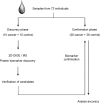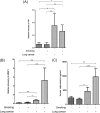Proteomic analysis of human saliva from lung cancer patients using two-dimensional difference gel electrophoresis and mass spectrometry
- PMID: 22096114
- PMCID: PMC3277759
- DOI: 10.1074/mcp.M111.012112
Proteomic analysis of human saliva from lung cancer patients using two-dimensional difference gel electrophoresis and mass spectrometry
Abstract
Lung cancer is often asymptomatic or causes only nonspecific symptoms in its early stages. Early detection represents one of the most promising approaches to reduce the growing lung cancer burden. Human saliva is an attractive diagnostic fluid because its collection is less invasive than that of tissue or blood. Profiling of proteins in saliva over the course of disease progression could reveal potential biomarkers indicative of oral or systematic diseases, which may be used extensively in future medical diagnostics. There were 72 subjects enrolled in this study for saliva sample collection according to the approved protocol. Two-dimensional difference gel electrophoresis combined with MS was the platform for salivary proteome separation, quantification, and identification from two pooled samples. Candidate proteomic biomarkers were verified and prevalidated by using immunoassay methods. There were 16 candidate protein biomarkers discovered by two-dimensional difference gel electrophoresis and MS. Three proteins were further verified in the discovery sample set, prevalidation sample set, and lung cancer cell lines. The discriminatory power of these candidate biomarkers in lung cancer patients and healthy control subjects can reach 88.5% sensitivity and 92.3% specificity with AUC = 0.90. This preliminary data report demonstrates that proteomic biomarkers are present in human saliva when people develop lung cancer. The discriminatory power of these candidate biomarkers indicate that a simple saliva test might be established for lung cancer clinical screening and detection.
Figures







References
-
- Ilie M., Mazure N. M., Hofman V., Ammadi R. E., Ortholan C., Bonnetaud C., Havet K., Venissac N., Mograbi B., Mouroux J., Pouysségur J., Hofman P. (2010) High levels of carbonic anhydrase IX in tumour tissue and plasma are biomarkers of poor prognostic in patients with non-small cell lung cancer. Br. J. Cancer 102, 1627–1635 - PMC - PubMed
-
- Hoagland L. F., 4th, Campa M. J., Gottlin E. B., Herndon J. E., 2nd, Patz E. F., Jr. (2007) Haptoglobin and Posttranslational glycan-modified derivatives as serum biomarkers for the diagnosis of nonsmall cell lung cancer. Cancer 110, 2260–2268 - PubMed
-
- Pleasance E. D., Stephens P. J., O'Meara S., McBride D. J., Meynert A., Jones D., Lin M. L., Beare D., Lau K. W., Greenman C., Varela I., Nik-Zainal S., Davies H. R., Ordoñez G. R., Mudie L. J., Latimer C., Edkins S., Stebbings L., Chen L., Jia M., Leroy C., Marshall J., Menzies A., Butler A., Teague J. W., Mangion J., Sun Y. A., McLaughlin S. F., Peckham H. E., Tsung E. F., Costa G. L., Lee C. C., Minna J. D., Gazdar A., Birney E., Rhodes M. D., McKernan K. J., Stratton M. R., Futreal P. A., Campbell P. J. (2010) A small-cell lung cancer genome with complex signatures of tobacco exposure. Nature 463, 184–190 - PMC - PubMed
-
- Hecht S. S. (2002) Cigarette smoking and lung cancer: chemical mechanisms and approaches to prevention. Lancet Oncol. 3, 461–469 - PubMed
Publication types
MeSH terms
Substances
Grants and funding
LinkOut - more resources
Full Text Sources
Other Literature Sources
Medical

